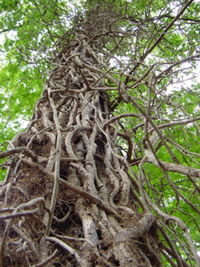





Who does not love an ivy-covered cottage? An ivy-covered wall? The friendly confines of ivy-covered Wrigley Field? Even the gods loved ivy. But it seems that quite a few mortals do not love ivy at all.
All true ivies are members of the genus Hedera and closely related to the common ivy, Hedera helix, which is often called English Ivy. The plant known as Boston ivy [Parthenocissus tricuspidata] is a member of the grape family, closely related to Virginia Creeper, another notable invasive plant. [The "ivy" covering the walls of Wrigley Field is actually Boston Ivy.]
True ivy has been known from ancient times. It was a symbol of the god Dionysos, who wore an ivy crown, as did his followers, known as bacchantes or mainads. They also carried a staff called the thyrsos, wrapped in ivy. Before he discovered the grape vine, Dionysos was said to have eaten the toxic berries of ivy in order to induce intoxication. Ivy has also been used as a symbol of Christmas, like many other evergreen plants, though the ivy takes a distant second place in the carol The Holly and the Ivy.
Ivy has two phases of growth. We most commonly see it as a woody, climbing evergreen vine that clings to surfaces by means of aerial roots. In this juvenile phase, its leaves are palmate, with three lobes. But in full sun mature ivy may develop a thick trunk without aerial roots, with heart-shaped leaves and insignificant flowers that develop into small black berries.
It prefers a shady location, and is valued because of its ability to thrive in deep shade, both indoors and out. While most ivies want a moist soil, at least one variety, H algeriensis, is drought-tolerant. Growers have produced a number of ornamental cultivars, many with variegated leaves. It is popular as a houseplant and a container plant, but ivy has most often been planted as a groundcover in shady areas, such as the north side of a house or beneath trees, and as a climber, to cover walls. It is precisely these properties, however, that have made it very unpopular in many quarters and led to its being considered invasive. Ivy is currently #8 in the list of Top Ten Thugs here at Dave's Garden, and the negative comments of gardeners are quite vehement in their condemnation. As a dense groundcover, it can crowd out other, native species. And as a climber, it has sometimes been considered destructive to walls and damaging to the trees it ascends.
In the garden, the vines can get out of hand, invading areas where they are not wanted if not constantly trimmed. When this happens, it is difficult to eradicate. Because of its waxy leaves, it resists herbicides. The roots can become thick and woody, too strong to pull out of the ground, and they will sprout again if cut back. Perhaps the best method, short of a backhoe, is to paint the cut surfaces of the trunks and roots with a very strong herbicide rated for killing brush.
Worse, when it escapes into the wild, usually spread by birds consuming the berries of the adult plant, ivy can cover a forest floor and crowd out native vegetation. For this reason, the states of Oregon and Washington have listed H helix or some of its cultivars [notably H hibernica and H baltica] as noxious weeds.

Another concern for the spread of ivy in forested area, as well as for trees in the garden, is the plant's climbing habit. The trunks of ivy, in warmer climates, can grow quite large and thick, completing for sunlight with the host and sometimes threatening to pull down the tree.
Here, as in many other cases, the critical factor is climate. I have a sizable bed of common ivy growing as a groundcover beneath some large [OK, overgrown] junipers at the north-east corner of my house in Zone 5, and I have been very happy with it. The ivy successfully chokes out weeds [although some Virginia Creeper did get a good start before I caught it] and produces a nice appearance. Once a year, I trim it to keep it in bounds. Although it has made some attempts at climbing the junipers, a sub-zero cold snap usually comes along and freezes the exposed vines on the trunks, killing the growth. The ivy has given me a lot less trouble in this respect than the Virginia Creeper.
In the warmer, damp rain forests of the US northwest coast, on the other hand, with no killing freezes to keep the ivy's growth checked, the vines can turn into monsters, justifying the opinions of gardeners who consider it a thug.
Photo Credit: Ivy on tree © 2005 by Nate Steiner http://creativecommons.org/licenses/by/2.0/
Copyright © www.100flowers.win Botanic Garden All Rights Reserved